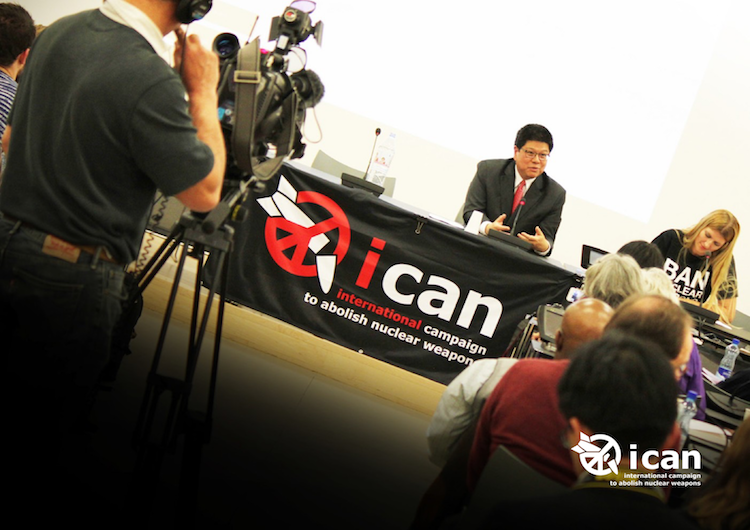Analysis by Ramesh Jaura
BERLIN (IDN) – While campaigners for a world free of nuclear weapons are confident that “a ban is coming”, the annual nuclear forces data launched by the Stockholm International Peace Research Institute (SIPRI) on June 13 gives little hope for optimism.
“Despite the ongoing reduction in the number of weapons, the prospects for genuine progress towards nuclear disarmament remain gloomy,” says Shannon Kile, Head of the SIPRI Nuclear Weapons Project. “All the nuclear weapon-possessing states continue to prioritize nuclear deterrence as the cornerstone of their national security strategies.”
But for the Geneva-based International Campaign to Abolish Nuclear Weapons (ICAN), “it is now clear beyond doubt that an overwhelming majority of the world’s nations are ready to start negotiations on a treaty banning nuclear weapons”. By putting in place a ban, they hope to stimulate much-needed progress towards the total elimination of nuclear forces.
This upbeat stance is grounded in deliberations of the May session of the 2016 United Nations open ended working group (OEWG) on nuclear disarmament in Geneva. The focus was on the proposal to start work on a global ban on nuclear weapons.
Ray Acheson of Reaching Critical Will points out that 127 states have signed the Humanitarian Pledge to fill the legal gap for the prohibition and elimination of nuclear weapons. These states submitted a proposal to the OEWG calling for the urgent pursuit a new treaty to prohibit and eliminate nuclear weapons.
The question for the OEWG Chair, Ambassador Thani Thongphakdi of Thailand, says Acheson, is whether or not he will reflect this overwhelming support and clear recommendations for the prohibition of nuclear weapons in his report for consideration of the UN General Assembly in September.
“The question for the nuclear-supportive states – who have articulated their support for nuclear weapons more strongly than ever before – is whether they will try to block a document with a clear recommendation from the majority of states. The question for those states wanting to pursue a prohibition is if they will accept anything less than what they have passionately and rightfully demanded at this meeting.”
Answers to Acheson’s questions will have to await the August session of the OEWG. But SIPRI’s data highlights some of the perturbing current trends and developments in world atomic arsenals.
The data shows that “while the overall number of nuclear weapons in the world continues to decline, none of the nuclear weapon-possessing states are prepared to give up their nuclear arsenals for the foreseeable future”.
According to the data, at the start of 2016, nine states – USA, Russia, UK, France, China, India, Pakistan, Israel and North Korea – possessed nearly 4,120 operationally deployed nuclear weapons – that is, warheads placed on missiles or located on bases with operational forces.
If all nuclear warheads are counted, explains SIPRI, the nine states together possessed a total of approximately 15,395 nuclear weapons compared with 15,850 in early 2015.
According to SIPRI, global nuclear weapon inventories have been declining since they peaked at nearly 70,000 nuclear warheads in the mid-1980s. The decline has been due primarily to cuts made in the Russian and U.S. nuclear forces as a result of three arms limitation treaties since 1991 as well as unilateral force reductions.
However, the pace of their reductions appears to be slowing compared with a decade ago, and neither Russia nor the USA – which together account for nearly 93% of nuclear weapons in the world – has made significant reductions in its deployed strategic nuclear forces since the 2011 bilateral Treaty on Measures for the Further Reduction and Limitation of Strategic Offensive Arms (New START), maintains SIPRI.
At the same time, the SIPRI data finds that, both Russia and the USA have extensive and expensive nuclear modernization programmes under way. The USA, for example, plans to spend $348 billion during 2015–24 on maintaining and comprehensively updating its nuclear forces. Some estimates suggest that the USA’s nuclear weapon modernization programme may cost up to $1 trillion over the next 30 years.
“The ambitious U.S. modernization plan presented by the Obama Administration is in stark contrast to President Barack Obama’s pledge to reduce the number of nuclear weapons and the role they play in U.S. national security strategy,” says Hans Kristensen, co-author to the SIPRI Yearbook.
Kristensen from Denmark is an Associate Senior Fellow with the SIPRI Disarmament, Arms Control and Non-proliferation Programme and Director of the Nuclear Information Project at the Federation of American Scientists (FAS).
The SIPRI data further shows that the other nuclear weapon-possessing states have much smaller arsenals, but have all either begun to deploy new nuclear weapon delivery systems or announced their intention to do so.
China, which has a stockpile of about 260 nuclear warheads, appears to be gradually increasing its nuclear forces as it modernizes the arsenal. India and Pakistan too appear to be expanding their nuclear weapon stockpiles and missile delivery capabilities.
At the beginning of 2016 India was estimated to have an arsenal of 100–120 nuclear weapons. This estimate, according to SIPRI, is an increase in the size of the Indian nuclear stockpile from the 90–110 warheads estimated in January 2015.
Pakistan was estimated to possess a stockpile of 110–130 warheads as of January 2016. This marked an increase from the 100–120 warheads estimated for 2015, notes SIPRI.
North Korea is estimated to have enough fissile material for approximately ten nuclear warheads. “However, it is unclear whether North Korea has produced or deployed operational weapons,” declares SIPRI. [IDN-InDepthNews – 13 June 2016]
IDN is flagship agency of the International Press Syndicate.
Image courtesy ICAN
2016 IDN-InDepthNews | Analysis That Matters
Send your comment | Subscribe to IDN newsletter
Follow us on Twitter and Facebook:
http://twitter.com/InDepthNews
http://www.facebook.com/IDN.GoingDeep

